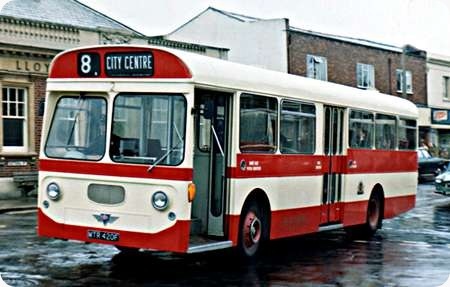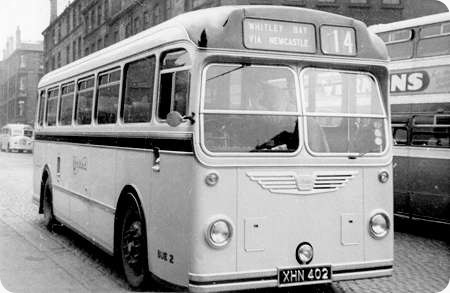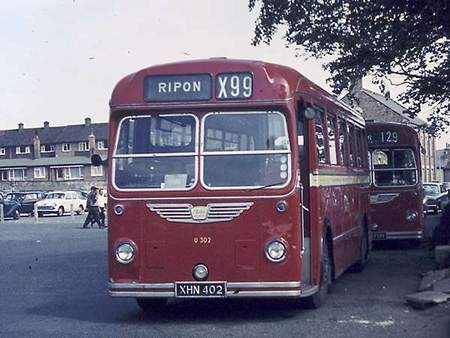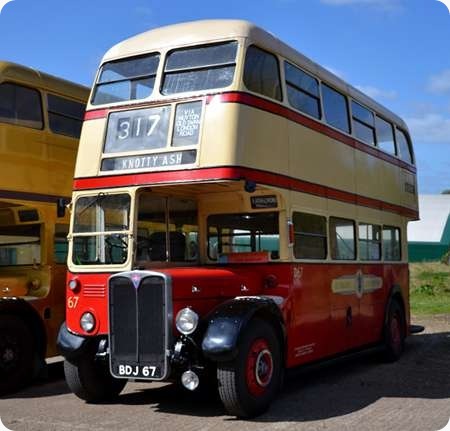
St Helens Corporation
1952
AEC Regent III RT
Park Royal H30/26R
BDJ 67 is one of the few Regent RT buses built for an operator other than London Transport. We see her here in full St Helens livery while taking part at the gathering at Brooklands on 13 April 2014. She has Park Royal H56R bodywork. St Helens had forty of these RTs taken in two batches, this actual vehicle and seventeen others were sold to Hull corporation in 1962. No, folks, it isn’t just a figment of Ken Dodd’s imagination – there really is a place called KNOTTY ASH!
Photograph and Copy contributed by Pete Davies
02/06/14 – 07:19
Not many of the RT’s who ‘escaped’ working for LTE had the traditional RT body. The St. Helen’s ones looked very smart in this livery, which was, of course, a much lighter colour on the top half.
Chris Hebbron
02/06/14 – 09:35
St Helens RTs even had a London Transport bullseye on the fuse box covers The eccentric way the blinds were used with a large number and squashed via points was interesting Incidentally St Helens also ran to Clock Face!
Chris Hough
02/06/14 – 10:45
The adjacent vehicle is NXP 997, RT4712, in Queen’s Golden Jubilee livery. She’s part of the LT collection and was on a day out from the Museum.
Pete Davies
03/06/14 – 07:43
This thread and Peter Williamson’s comments regarding Southport in the A Matter of Opinion thread have really stirred some memories. In 1954 my Dad bought a Standard 9 and on certain summer Sundays we would proceed in a stately fashion to either Southport or Blackpool. We would rarely make either as my mother preferred the "more refined" areas of Ainsdale and Lytham St Anne’s!
The St Helens RTs were a sight to behold as they crossed the East Lancs Rd or proceeded on the service to Southport. The colour scheme, like Southport’s (and for that matter Stockport’s) always was cleanly presented and looked a cut above most other towns and cities in the North West.
The large surround to the coat of arms was also "different" though why the Department used the blind layout it did is a mystery to me. It sort of spoiled the overall effect and, with a substantial fleet of these vehicles surely using the indicator spaces as intended would not have been a significant extra cost.
Cross referencing again to Peter on the other thread, I well remember the DUKWs -and the Bedfords that eventually ran on the sands. Southport probably had the smartest all Leyland PD2s of all and, operating alongside the St Helens RTs the enthusiast, myself included had the unique experience of seeing, in my opinion, THE pinnacle of UK bus design of the era running side by side every day.
Phil Blinkhorn
On the surface of it these were strange purchases for a Lancashire municipality. However it is easier to understand when one learns that the GM at St Helens at the time was R Edgeley Cox who had a hand in the design and development of the RT when he was in a previous post with LTE. Despite being ‘high quality’ vehicles they had relatively short lives at St Helens as they apparently fell foul of a subsequent GM’s views on operating costs after Mr Cox had moved on to Walsall. The preselector transmission gave lower MPG than manual gearbox buses and as a result the RT’s were sold on in the early 1960’s.
Philip Halstead
03/06/14 – 11:14
Thanks for your various comments, gents. The pinnacle of UK bus design, Mr Blinkhorn – the QL and the DUKW? You’re jesting, of course!
Pete Davies
One wonders if the purchase price was favourable, bearing in mind that they were purchased as part of a large on going LTE order. This might have helped to defray subsequent running costs somewhat.
Chris Hebbron
04/06/14 – 08:07
Pete, is anno domini getting to you? The PD2 and RT is what I said but, come to think of it, the DUKW and the QL could be the pinnacle of municipal transport oddity. Are there other contenders? Llandudno may be a good starting point.
Phil Blinkhorn
04/06/14 – 08:07
The book ‘Local Transport in St Helens’ by Maund & Ashton states that the RT had a lower overall height than conventional highbridge buses and that this was another reason for their purchase as St Helens had some height restricted routes. I was never aware of this feature of the RT but would welcome any comments from those with greater London knowledge.
I agree with Phil that the rather obscure use of the standard London destination display did spoil the appearance and detract from the very attractive livery. When several of them were sold on to Hull they were fitted with that operator’s standard blind display and were given another very attractive livery, the streamlined blue and white/cream.
Philip Halstead
04/06/14 – 08:08
This is a far more interesting story than at first appears, probably because the name R Edgeley Cox comes into it. The appearance of these buses- emphasised by the livery- belies their date, even though other (relatives?) such as CH Roe were producing some smart looking bodies oop north by the early fifties. The odd thing is the destination boxes- you would think it would not be a big issue to alter them to suit the purchaser- or were they really an off the peg or cancelled-order deal? And if these buses were available to buy (unlike Bristol/ECW) why didn’t more municipalities buy them? This was surely the age of the preselector- and hundreds of Daimler CVD’s of that era survived a full innings. So what did St Helens buy instead after 10 years? Atlanteans?
Joe
04/06/14 – 09:13
Joe, St Helens never operated Atlanteans operating a mixed fleet of Regent Vs and PD2s.
Phil Blinkhorn
04/06/14 – 15:17
I knew exactly what you meant, Phil. I was just being suitably provocative to match my Welsh background!
Pete Davies
04/06/14 – 15:17
Malcolm Keeley’s Buses in Camera ‘Mercian and Welsh’ has a good colour shot showing two of the Bedford QL’S on Ainsdale beach.
Roger Broughton
04/06/14 – 18:15
Pete, I have a Welsh friend who lives just down the road. You have just explained a great deal!!
Phil Blinkhorn
05/06/14 – 07:32
Phil, I could tell you about the "Honorary Welshman" contests we had a College on St David’s Day, but it isn’t fit for ‘family viewing’!
Pete Davies
05/06/14 – 07:33
Phil- the Atlantean reference was a bit of irony… but can’t see the logic of presumably losing money on the early sale of these RT assets: perhaps Hull made them an offer they couldn’t refuse…
Joe
07/06/14 – 08:22
I believe the RT was only 14’3" high, although how that was achieved I have no idea. It makes sense for this to have been part of the attraction, because St Helens also had its own unique version of the Leyland PD2 – the PD2/9 – on which bodywork of reduced height could be built.
Regarding the early disposal, Joe may have hit on something. There was a lot of networking between municipal managers in those days. I can just imagine the St Helens guy grumbling about a daft legacy left by his predecessor, and I can imagine the Hull guy saying there had never been a better bus than the preselective Regent III, next best thing to a trolleybus, wish they were still available etc etc. Next thing you know, a deal is done and everyone’s happy.
Peter Williamson
08/06/14 – 07:20
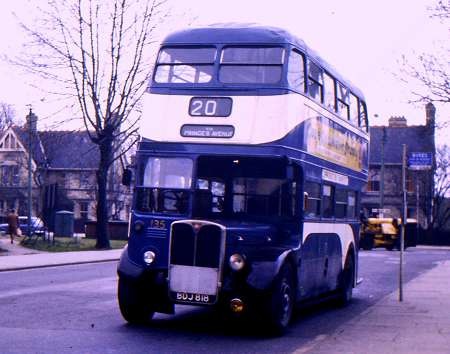
A more suitable destination indicator set on an ex-St Helens RT as produced in Hull. No. 135 was photographed by me on 11 April 1967.
Malcolm J Wells
08/06/14 – 07:21
The destination "Knotty Ash" on a St Helens Corporation blind threw me, as it seemed to be an unusual short working for a bus on the 317 to Liverpool.
So I read page 40 of "Local Transport In St Helens" (Venture Transport) and all became obvious.
Greyhound racing was a popular pastime in St Helens, and additional buses were put on to Knotty Ash Stadium on race nights.
Then in 1950, Liverpool Stanley RLFC relocated to Knotty Ash Stadium as Liverpool City RLFC.
I doubt that St Helens RLFC played many matches at Knotty Ash, due to the teams being in different divisions, but there is a photo in the book showing 10 St Helens RTs parked on East Prescot Road (opposite Dovecote Baths) for an event.
As an aside, my dad lived in Knotty Ash in the 1920s in 9th Avenue, on an estate of prefabricated "cabins" built as a rest camp for the U.S. Cavalry on their way to/from the Western Front.
This site was adjacent to Knotty Ash Station (well worth a read on the Disused Stations website) www.disused-stations.org.uk/k/knotty_ash/ as are all the stations of the Cheshire Lines Committee.
Dave Farrier
08/06/14 – 09:51
Reading further in the Maund and Ashton book, the reason why the RT was not more popular with provincial operators may have been its cost – almost £500 per bus, compared to a standard Regent III, a considerable amount at that time. Also, I don’t think it was just the PD2/9s which were of reduced height – further on in the chapter it is mentioned that all the 1956/1957 deliveries had the "now standard configuration…of reduced height", and I think this can be discerned looking at photos of St. Helens DDs. And regarding the short life of the RTs, at the time St Helens did keep their vehicles for a relatively short time compared to other north-west municipals; in 1967, whilst still buying new rear-entrance DDs, they were already selling the 1956/57 PD2s which would have probably been considered profligate at Stockport, for instance!
Michael Keeley
11/06/14 – 08:12
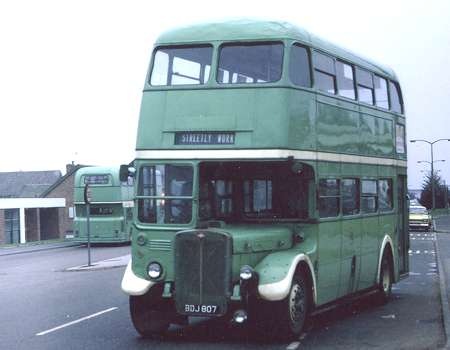
Some of the St Helens RTs were bought by Harper Brothers of Heath Hayes, neighbours to Walsall Corporation and R. Edgeley Cox. Both operators shared a 14’3" bridge in Cannock.
Walsall also had 5 ex LT RTLs, but they were limited to the routes they could be used on because of their height.
Tony Martin
11/06/14 – 11:28
Didn’t I also read that the suspension and profile of the tyres on RTs contributed to their "low height" characteristics?
David Oldfield
30/10/14 – 15:14
Besides the one AEC RT that is in a Scottish museum are there any more of the forty still surviving.
Mr Anon
23/06/15 – 06:32
BDJ 807 had been kept at Rugeley Trent Valley for many years but has now vanished. Does anyone know where it is now?
Tony Martin
 Vehicle reminder shot for this posting
Vehicle reminder shot for this posting
04/12/17 – 08:47
The ex-St. Helens RT formerly parked at Rugeley was acquired by Ensign and is currently being restored to be part of their vintage fleet. The company have a very interesting blog that provides news and pictures – //ensignvintagebuses.blogspot.com
Jonathan Cadwallader
